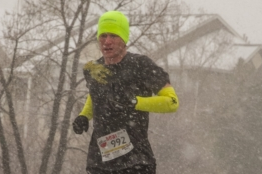One feature I would love in any race is to have a person to stick with who I know is running my goal pace. Even though running is mostly repetitive motion, it’s much easier to stay at a certain pace if you’ve got someone to run with. It takes the thinking and in-race math out of the equation and I will attest that math gets very sketchy in the latter stages of a race. I write my projected splits on an index card and tape it to my wrist so I don’t have to do the math. I just hit the mile marks, look at the card and my watch, and adjust if necessary. But, that’s not the same as having someone to stick with.
In many professional races, pacers will be employed to lead the field and keep the top runners at a pre-determined speed whether it’s for a world, national, or even course record. Sometimes it works brilliantly, such as when Brigid Kosgei broke the world marathon record in Chicago last year. Sometimes it doesn’t work and the field gets nowhere close to the record. Occasionally the pacers don’t pan out but a record is set anyway, such as when Kipchoge set the marathon world record in Berlin in 2018.
I’ve paced people in workouts and it’s fun. The key with pacing, whether it’s for a race or workout, is that you want whoever’s pacing to be able to hold whatever time you agree on without having to completely max themselves out. They need to be able to hold an even speed. When I did some 4 X 800M workouts with a friend, he wanted a pace I knew wouldn’t be too hard to keep. I hit every 200M split right on target, he got the times he wanted, and I got to practice running in a very controlled way.
A couple of weeks ago a friend of mine offered to pace me in a 5K time trial. He’s faster than me and the pace we chose would be one that he could hold without too much strain. He would fold it into a longer workout at that speed and I would be pushing myself to where I thought my current top 5K is. After a brisk two-mile warmup, we set off on a 5K out-and-back course. We kept at the pace we wanted and through most of the first half, I was charging up the small hills fairly well and feeling pretty good while holding even with him.
Right before the turnaround, I was starting to lag. After we finished, my friend commented that at that point he thought I was done at that speed and during the run, I was thinking the same thing. But here’s what makes a difference. Not only was I still close to the pace but he was holding the time we wanted and I could see exactly where that was. Instead of being on my own on a course, feeling the mid-race burn, and wondering exactly how much faster I had to go to catch up to the pace, I could see where I needed to be. Partly because of this, somewhere in the next quarter mile I found a second wind. While I fell off by a small bit over the next mile-plus, I could always see where I needed to get and though I was wondering just how I could hold on, having someone to work with helped tremendously.
While I enthusiastically recommend pacing on both sides, it is tricky. Even if you have a pacer who can hold the tempo you want relatively easily, there are other factors. I tend to go out too fast so while I would be glad to pace someone in an open road race or time trial, I would need to do some preparatory work. That might involve running with the person a fair amount leading up to it, and at least practicing running at that pace so it became second nature. But, it’s well-worth the effort and it’s a huge boost to the person being paced. For the pacer, there’s not only the reward of helping someone out, you also can develop your own skills in terms of moderating your own running and learning or reinforcing how to run in a controlled way.

Running anecdotes, running food reviews, some race coverage, and more